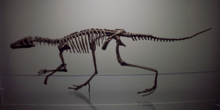Lagosuchus
| Lagosuchus | |
|---|---|

| |
| Mounted skeleton (based on specimens previously referred to Marasuchus) | |
| Scientific classification | |
| Domain: | Eukaryota |
| Kingdom: | Animalia |
| Phylum: | Chordata |
| Clade: | Ornithodira |
| Clade: | Dinosauromorpha |
| Order: | †Lagosuchia Paul, 1988 |
| Family: | †Lagosuchidae Bonaparte, 1975 |
| Genus: | †Lagosuchus Romer, 1971 |
| Species: | †L. talampayensis
|
| Binomial name | |
| †Lagosuchus talampayensis Romer, 1971
| |
| Synonyms | |
| |
Lagosuchus is an extinct
A second potential species of Lagosuchus, L. lilloensis, is based on an assortment of slightly larger and more well-preserved fossils.
History

The
Modern authors now consider at least L. lilloensis to be firmly on the lineage of archosaurs leading to dinosaurs.
The Chañares Formation's age has been through much debate. It has traditionally been considered to belong to the Ladinian stage, the last stage of the Middle Triassic. Radiometric dating in 2016 has dated the main fossiliferous section of the formation to the early Carnian stage, near the start of the Late Triassic.[7]
Description
Lagosuchus talampayensis, in its most restricted form, can only be described based on the incomplete holotype skeleton. It was a lightly built archosaur, with long, slender legs and well-developed feet - features it shares with certain dinosaurs.
Vertebrae and forelimbs

The dorsal (trunk) vertebrae had centra about three times longer than tall, slightly more elongated than those referred to Marasuchus. Yet the dorsals also had many traits in common with Marasuchus, such as large excavations below the transverse processes. In addition, they both have trapezoidal neural spines with thickened upper edges which expand forwards and backwards to contact those of adjacent vertebrae. The contemporary silesaurid Lewisuchus has a similar neural spine morphology, but it possesses osteoderms on its neural spines, unlike Lagosuchus and Marasuchus. The two sacral (hip) vertebrae had large and slightly tapering transverse processes. This is also the case for the first four caudal (tail) vertebrae at the base of the tail. Further back, the caudals have much shorter transverse processes and more elongated centra, like those of Marasuchus.[3]
The scapula (shoulder blade) was narrow, with a slightly expanded upper tip and a thick longitudinal ridge on its inner surface. The humerus was also quite narrow, with a subtriangular deltopectoral crest in its upper part. The deltopectoral crest extends about 31% down the length of the humerus, making it somewhat less extensive than that of other avemetatarsalians (including Marasuchus). The radius and ulna are thin, simple, and unusually short, only about 65% the length of the humerus. In contrast, Marasuchus has a larger ulna with a strong olecranon process.[3] The forelimbs in general were much smaller than the hindlimbs.[1]
Hip and hindlimbs
The pelvis (hip) is similar to that of Marasuchus, with a thin pubis and a plate-like ischium which has a large ridge on its rear edge. The femur is elongated and has a slightly inturned femoral head. The femoral head is characteristically 'globose', with a strong projecting convex surface stretching up along its inner and upper portions. This trait is shared with Marasuchus and lagerpetids. The femur also possessed a knob-like anterior trochanter and a distinct fourth trochanter. The tibia and fibula were narrow and about 10% longer than the femur. Like other dinosauriforms, the tibia had a strong cnemial crest at the knee and a lateral groove near the ankle. The ankle has a small distal tarsal 3, a larger distal tarsal 4, and a rounded astragalus, but the calcaneum is missing from the fossil. The middle three metatarsals are elongated, with metatarsal III as the longest. Metatarsal V is short and tapers to a sharp tip. Metatarsal I is also short, though still longer than V (unlike Marasuchus). Phalanges are slender, and an isolated pedal ungual (toe claw) is weakly curved and flattened sideways.[3]
Palaeobiology
Metabolism
It is believed that Lagosuchus and Marasuchus were transitional between
References
- ^ a b c d Romer, Alfred Sherwood (15 June 1971). "The Chañares (Argentina) Triassic reptile fauna. X. Two new but incompletely known long-limbed pseudosuchians". Breviora. 378: 1–10.
- ^ .
- ^ S2CID 201949710.
- ^ a b c Romer, Alfred Sherwood (11 August 1972). "The Chañares (Argentina) Triassic reptile fauna. XV. Further remains of the thecodonts Lagerpeton and Lagosuchus". Breviora. 394: 1–7.
- ^ S2CID 83493714.
- ^ a b Jose, Bonaparte (1975). "Nuevos materiales de Lagosuchus talampayensis Romer (Thecodontia-Pseudosuchia) y su significado en el origen de los Saurischia: Chañarense inferior, Triásico medio de Argentina" (PDF). Acta Geológica Lilloana. 13 (1): 5–90.
- PMID 26644579.
- ISBN 978-1-84028-152-1.
- ^ Paul, Gregory (1988). Predatory dinosaurs of the world. Simon & Schuster.
- ^ Holtz, Thomas R. Jr. (2012) Dinosaurs: The Most Complete, Up-to-Date Encyclopedia for Dinosaur Lovers of All Ages, Winter 2011 Appendix.
- PMID 19911059.
